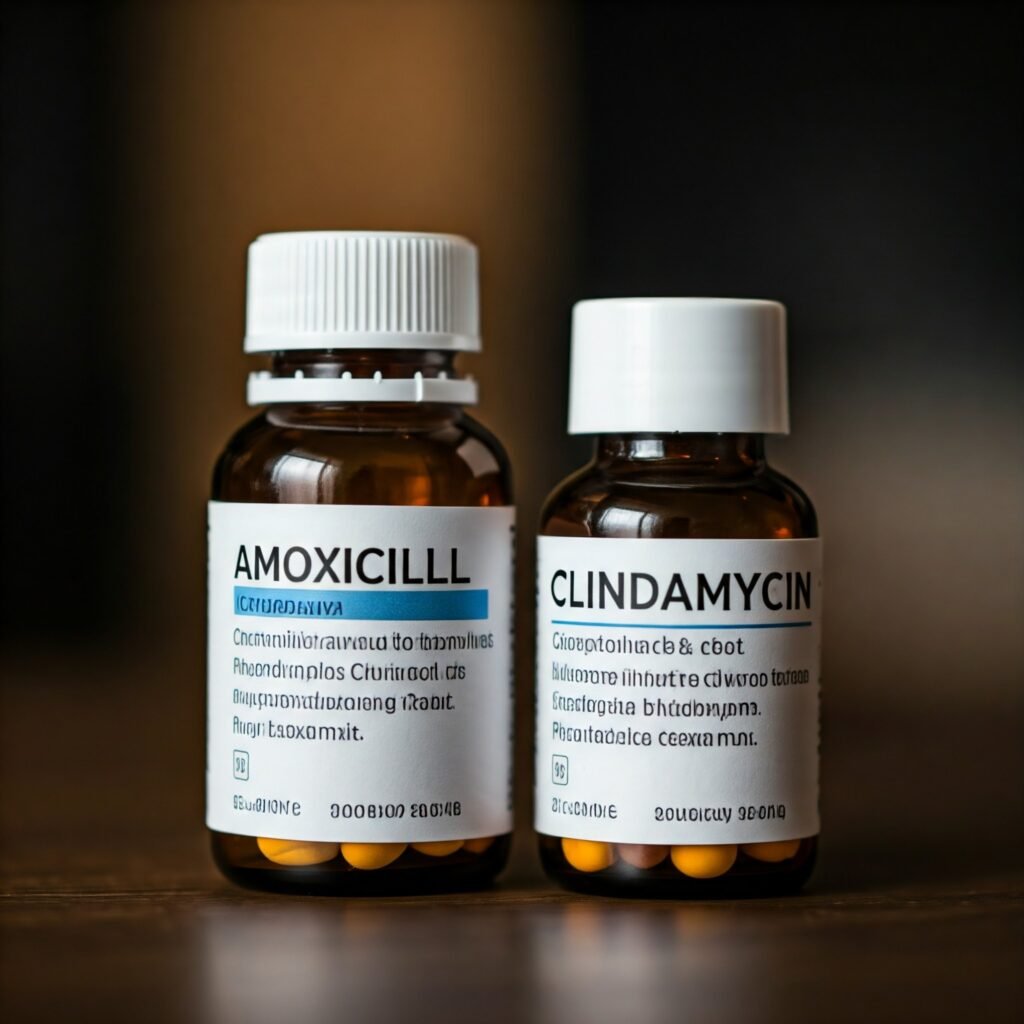Table of Contents

- Amoxicillin and Clindamycin are both antibiotics used to treat bacterial infections.
- While they can be effective medications on their own, combining them may not always be the best course of action
- Yes, you can take amoxicillin together with clindamycin, as there are generally little to no significant interactions between the two antibiotics.
- Both medications are used to treat bacterial infections, but they target different types of bacteria.
- Amoxicillin is a penicillin-type antibiotic effective against a variety of bacteria, while clindamycin is effective against anaerobic bacteria and certain protozoa.
- However, they have different mechanisms of action and can interact with each other in complex ways.
- When taken together, they can increase the risk of diarrhea, C. diff infection, and allergic reactions.
What are the potential risks of taking amoxicillin and Clindamycin together?
- Increased risk of diarrhea: The study showed in The American Journal of Managed Care® 2023 that taking amoxicillin and Clindamycin together can increase the risk of diarrhea, which can be a significant problem, especially in older adults and young children.
- Increased risk of C. diff infection: A study showed in Open Forum Infectious Diseases 2023 C. diff is a type of bacteria that can cause diarrhea and colitis. Taking amoxicillin and Clindamycin together can increase the risk of C. diff infection, which can be life-threatening.
- Increased risk of allergic reactions: the study showed in Clinical Reviews in Allergy & Immunology 2021Amoxicillin and Clindamycin can cause allergic reactions, and taking them together can increase the risk of these reactions.
- Drug Interactions with Other Medications: Both antibiotics can interact with other medications you may be taking. For example, oral contraceptives may be less effective when taken with amoxicillin or clindamycin.
- Other Potential Side Effects: Other possible side effects include headache, dizziness, and skin rash.
What are the potential benefits of taking amoxicillin and Clindamycin together?
Effective treatment of mixed bacterial infections:
- Some infections may involve a combination of different types of bacteria, including both aerobic and anaerobic bacteria.
- Amoxicillin is primarily effective against aerobic bacteria, while clindamycin is effective against anaerobic bacteria. Combining these antibiotics can provide broader coverage and increase the likelihood of successful treatment.
- Amoxicillin and Clindamycin can be used together to treat polymicrobial bacterial infections, such as pneumonia, skin infections, and urinary tract infections.
Reduced risk of antibiotic resistance:
- Taking amoxicillin and Clindamycin together can reduce the risk of antibiotic resistance, which is a growing concern in the medical community.
How can I minimize the risks of taking amoxicillin and Clindamycin together?
Consultation with a Healthcare Provider:
- Always consult with a doctor or pharmacist before taking any new medications, including antibiotics.
- Discuss your medical history with your healthcare provider, including any allergies, existing medical conditions, and other medications you are taking.
- Follow your doctor’s instructions carefully regarding dosage, duration of treatment, and any necessary precautions.
Monitoring for Side Effects:
- Monitor yourself for any side effects while taking these medications, such as diarrhea, nausea, vomiting, or allergic reactions.
- Contact your doctor immediately if you experience any severe side effects.
Proper Dosing and Administration:
- Take the medications exactly as prescribed by your doctor.
- Do not stop taking the medications early, even if you start to feel better.
- Finish the full course of antibiotics as directed to ensure that the infection is completely cleared.
FAQs for Can I take amoxicillin together with Clindamycin?
Can I take amoxicillin and Clindamycin together if I have a history of diarrhea?
It’s essential to consult with a healthcare provider before taking these medications together, especially if you have a history of diarrhea.
What are the potential side effects of taking amoxicillin and Clindamycin together?
The potential side effects of taking amoxicillin and Clindamycin together include diarrhea, C. diff infection, and allergic reactions.
Can I take amoxicillin and Clindamycin together if I’m pregnant or breastfeeding?
It’s essential to consult with a healthcare provider before taking these medications together, especially if you’re pregnant or breastfeeding.
Can I take probiotics while taking amoxicillin and clindamycin?
Probiotics may help to maintain a healthy gut microbiome and reduce the risk of diarrhea. However, it’s essential to discuss this with your doctor before taking probiotics.
What should I do if I experience diarrhea while taking these antibiotics?
Mild diarrhea can often be managed with over-the-counter medications such as loperamide. However, if you experience severe diarrhea, bloody stools, or signs of dehydration, contact your doctor immediately.
Can I drink alcohol while taking amoxicillin and clindamycin?
It’s generally best to avoid alcohol while taking antibiotics, as it can increase the risk of side effects.











Comment:
Thank you for sharing such a detailed and informative
post about taking Amoxicillin and Clindamycin together. It’s crucial to understand
the potential risks and benefits of combining different antibiotics, and
this post does a great job of explaining them.
One thing that stood out to me was the point about the increased risk of diarrhea and C.
diff infection when taking these antibiotics together.
It’s important for patients to be aware of these risks and to contact their healthcare provider immediately if they
experience severe side effects.
I also appreciated the emphasis on consulting with a healthcare
provider before taking these medications together, especially for those who have a history of diarrhea,
are pregnant or breastfeeding, or are taking
other medications. It’s always best to err on the side of caution and to discuss any potential interactions with a medical professional.
Overall, this post provides valuable information for anyone who may be considering taking Amoxicillin and
Clindamycin together. Thanks again for sharing this helpful resource!
Thank you for your thoughtful feedback! I’m glad the post was helpful and highlighted key points like the risks of diarrhea and C. diff infection. You’re absolutely right—consulting with a healthcare provider is crucial when combining medications. I appreciate your support!
Yay google is my king assisted me to find this great internet site! .